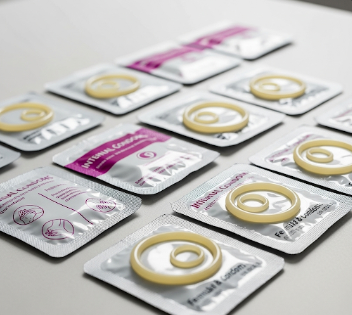What it is
Internal condoms, also known as female condoms, are barrier devices worn inside the vagina to prevent pregnancy and reduce the risk of sexually transmitted infections (STIs), including HIV. They are made from thin, flexible materials such as nitrile, polyurethane, or latex, and are designed for single-use.
Key points:
- Provides dual protection: prevents both pregnancy and STIs.
- Can be inserted hours before sexual activity, allowing spontaneity.
- Made with a closed-end inner ring that stays inside the vagina and an outer ring that remains outside to cover part of the vulva.
- Does not require a prescription and can be used as part of family planning or safer sex practices.
Why it’s done
Internal condoms are used to:
- Prevent unintended pregnancy: Barrier method prevents sperm from reaching the egg.
- Reduce risk of STIs: Protects against HIV, gonorrhea, chlamydia, syphilis, and other infections.
- Empower women: Provides a method of protection that can be controlled by the receptive partner.
- Alternative to male condoms: Useful when male partners are unable or unwilling to use a condom.
- Complementary contraceptive method: Can be used with spermicides or other contraceptives for added protection.
Note: While effective, internal condoms must be used correctly to maximize protection.
Alternatives
Other contraceptive and protective options include:
- Male condoms: Most common barrier method for pregnancy and STI prevention.
- Oral contraceptives or hormonal methods: Pills, patches, injections, or implants.
- Intrauterine devices (IUDs): Highly effective for pregnancy prevention but do not protect against STIs.
- Diaphragms or cervical caps: Barrier methods placed over the cervix.
- Dual protection strategy: Using condoms along with hormonal contraceptives for maximum effectiveness.
Important: Internal condoms are unique in providing both pregnancy and STI protection while being female-controlled.
Preparation
Correct preparation ensures effective and safe use:
- Check the expiration date: Expired condoms may be less effective or prone to tearing.
- Inspect packaging: Ensure the condom is intact, undamaged, and unopened.
- Lubrication: Water-based or silicone-based lubricants may be applied to ease insertion and reduce tearing. Avoid oil-based lubricants with latex condoms.
- Positioning: Familiarize yourself with anatomy and insertion technique.
Patient instructions:
- Wash hands before handling the condom.
- Open the package carefully without tearing the condom.
- Practice inserting in a comfortable, private setting if first-time use.
How it’s done
Internal condom usage involves the following steps:
- Hold and insert: Squeeze the closed-end inner ring and insert it deep into the vagina.
- Position the outer ring: Ensure it remains outside the vaginal opening, covering part of the vulva.
- During intercourse: Guide the penis into the condom to prevent slippage or misalignment.
- After intercourse: Twist the outer ring gently and pull out the condom slowly to avoid spilling contents.
- Disposal: Wrap in tissue and dispose of in the trash; do not flush.
Tips for effectiveness:
- Use one condom per sexual act.
- Avoid reusing condoms.
- Combine with lubrication to reduce friction and tearing.
Recovery / Post-Use Considerations
Internal condoms are single-use, so no medical recovery is needed. Post-use considerations include:
- Check for breakage: Replace immediately if the condom breaks or slips.
- STI testing: If condom failure occurs during unprotected exposure, consult a healthcare provider.
- Pregnancy prevention: Consider emergency contraception if a condom fails and risk of pregnancy exists.
- Comfort and hygiene: Mild vaginal irritation is rare; wash external genitalia if needed.
Benefits of correct use:
- Highly effective at preventing pregnancy and STIs.
- Provides female-controlled sexual protection.
- Can be used with other contraceptive methods for dual protection.
Complications / Risks
Internal condoms are generally safe, but potential issues include:
- Discomfort or noise: Some users notice slight sliding, friction, or rustling sound.
- Allergic reaction: Rare, usually due to latex sensitivity.
- Slippage or misalignment: May reduce effectiveness in preventing pregnancy or STIs.
- Breakage or leakage: More likely if incorrectly inserted or lubricated with oil-based products.
Prevention:
- Use correct insertion technique.
- Check expiry and integrity before use.
- Use compatible lubricants (water-based or silicone-based).
- Follow the instructions provided with the condom.
Treatment Options in Korea
Internal condoms are widely available in Korea for sexual health and family planning:
Key features:
- Available in pharmacies, clinics, sexual health centers, and online platforms.
- Offered in different sizes, materials, and pre-lubricated options.
- Recommended by gynecologists and sexual health practitioners for dual protection.
- Can be combined with other contraceptive methods for enhanced protection.
- Educational programs in Korea provide guidance on correct use and safe sex practices.
Summary: Internal (female) condoms in Korea are a safe, female-controlled, and effective method of preventing pregnancy and sexually transmitted infections. When used correctly, they empower women to take active control of their sexual health, offering a valuable alternative or complement to male condoms.













